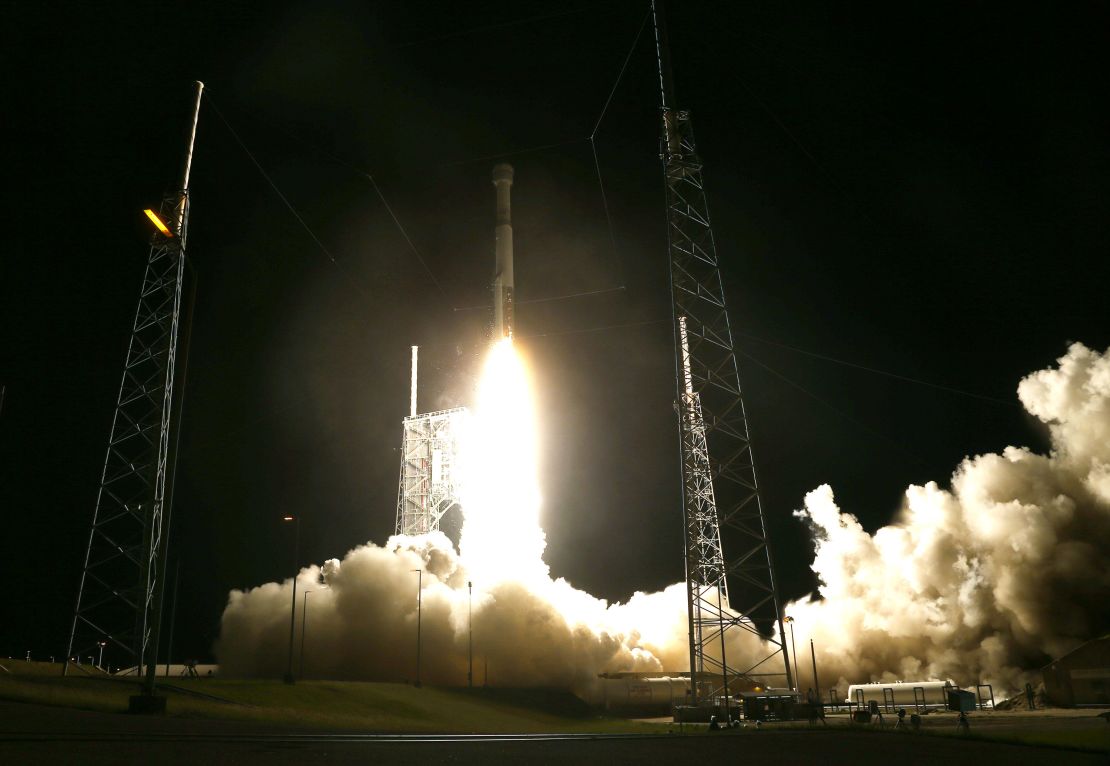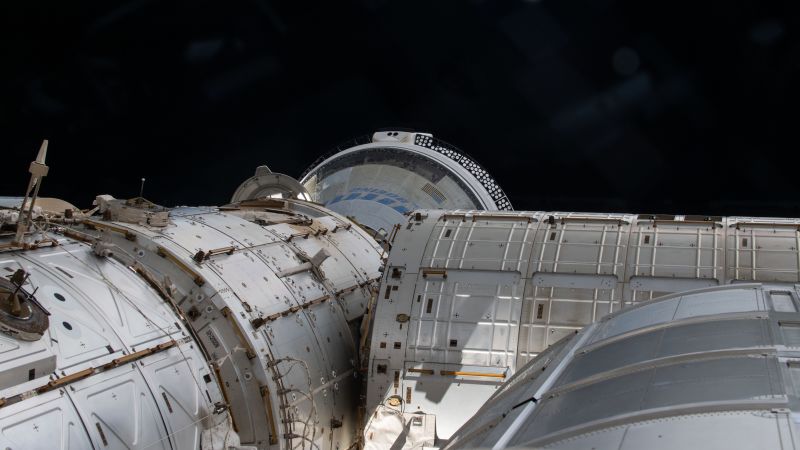Sign up for CNN’s Science of Miracles newsletter. Explore the universe with news of fascinating discoveries, scientific advances and more.
CNN
–
A SpaceX Crew Dragon capsule will bring home two NASA astronauts who have been stuck aboard the International Space Station for about 80 days due to problems plaguing the Boeing Starliner spacecraft – marking a stunning turnaround events for the beleaguered aerospace giant.
The news comes after the space agency held a formal review Saturday to determine whether it would deem Boeing’s Starliner vehicle safe enough to return home with its crew — or whether SpaceX’s Crew Dragon spacecraft would have to step in. to save the day.
The Starliner vehicle, which carried astronauts Suni Williams and Butch Wilmore to the space station in early June, experienced problems with helium leaks and thrusters that suddenly stopped working during the initial part of its first crewed test flight. Engineers spent weeks trying to better understand the issues, and Boeing said on August 2 that its “confidence remains high” that the spacecraft would be able to return Williams and Wilmore to Earth.

NASA revealed during an Aug. 7 news conference, however, that discussions within the space agency about the safety of the Starliner capsule had evolved — prompting the federal agency to more seriously consider flying astronauts home in a SpaceX Crew Dragon vehicle, which has flown about a dozen. crewed mission in space since 2020.
On Saturday, NASA Administrator Bill Nelson said NASA considered its extensive experience with spaceflight — both successful and unsuccessful — when making the decision. A survey of NASA representatives from all of the agency’s research, oversight, and development departments and centers it was unanimous, according to agency officials.
“We’ve had mistakes made in the past: We lost two spacecraft as a result of not having a culture in which information could come forward,” Nelson said. “Space flight is dangerous, even in the safest and even most routine case. And a test flight, by nature, is neither safe nor routine.
SpaceX is already scheduled to execute a routine mission to the International Space Station, carrying four astronauts as part of standard crew rotations at the orbital laboratory. But the mission, called Crew-9, will now be reconfigured to carry two astronauts on board instead of four.
This arrangement will leave two empty seats for Williams and Wilmore to fill on the Crew-9 flight home. The astronauts will also join the Crew-9 team, becoming part of the official ISS expedition. With that transition, Williams and Wilmore will stay in place for another six months — the length of a routine mission to the space station.
The reassignment to Crew-9 will push the pair’s return to February 2025 at the earliest.
However, the Starliner will fly home empty in early September, NASA said Saturday.
If the uncrewed return trip goes well, NASA will then face a critical decision: whether to give the Starliner official certification for human spaceflight — a step that would position the vehicle to make routine trips to orbit – despite the fact that it did not fulfill its mission as intended.
No Boeing representative was present at Saturday’s press conference.
In a statement on Saturday, Boeing said it “continues to focus, first and foremost, on the safety of the crew and the ship. We are executing the mission defined by NASA and preparing the spacecraft for a safe and successful unmanned return.”
Steve Stich, NASA’s commercial crew program manager, said Saturday that there was “only a little disagreement (between NASA and Boeing) as to the level of risk.”
“It just depends on how you assess the risk,” Stich said. “We did it a little differently with our crew than Boeing.”
Nelson later added that he is “100%” confident that Boeing will address the issues and get the Starliner up for another crewed mission at some point in the future.
SpaceX Chief Operating Officer Gwynne Shotwell also responded to the news with a post on X, the social media platform formerly known as Twitter.
“SpaceX is ready to support @NASA in any way we can,” Shotwell said.
Five of the Starliner’s 28 “feedback control thrusters” went haywire during the first stretch of Boeing’s test mission. All but one were eventually found.
And while Williams and Wilmore expected to spend just eight days in space, their stay at the orbiting lab has already been extended by roughly two months as engineers on the ground worked to better understand the thruster’s problems.
Officials said they were able to recreate how the thrusters in space deteriorated during the flight with tests on the ground. The likely root cause was heat build-up inside the thrusters that can cause insulating seals to blow, restricting thruster flow, Boeing said.
Separately, problems with helium leaks may be the result of seals that have degraded due to exposure to fuel vapor, according to comments from Mark Nappi, Boeing’s commercial crew program manager, on July 25.
However, NASA initially struggled to reach a consensus on how these issues might affect the return of astronauts from space – and how much risk the problems would pose.
The uncertainty surrounding the level of risk is why the agency is turning to SpaceX and its Crew Dragon spacecraft to intervene, Stich said Saturday.
“The bottom line about the Starliner return is — there was a lot of uncertainty in predicting the propellants,” he said. “It was just too much of a risk with the crew, and so we decided to go the unmanned route ahead.”
NASA has repeatedly said that SpaceX’s capability to enter highlights how the space agency deliberately designed its Commercial Crew Program — under which both Starliner and Crew Dragon were developed — to allow each spacecraft to serve as a backup for the other.
“We’re kind of in a new situation here, and we have multiple options,” Ken Bowersox, associate administrator for NASA’s Space Operations Mission Directorate, said on Aug. 7. “That’s something we’re going to have to deal with in the future — we may find ourselves in a situation where we have to return a (SpaceX) Dragon crew or a (Russian) Soyuz crew to a Starliner.
“That’s why we want multiple vehicles — so we have that option,” Bowersox added.
However, the federal agency funded SpaceX’s Crew Dragon and Boeing’s Starliner at the same time in 2014. Crew Dragon has already been in operation for four years, while the Starliner program is hundreds of millions of dollars over budget and years behind schedule.
Boeing’s development process has also been plagued by missteps.
For example, the first Starliner test mission — flown in 2019 without a crew — misfired in orbit and aborted the flight far short of expectations. The vehicle ultimately did not dock with the space station as intended, and the result was found to be a symptom of a host of software problems, including a coding error that threw the internal clock off by 11 hours.

A second uncrewed flight test in May 2022 revealed additional software problems, and mission teams addressed problems with some of the vehicle’s thrusters. However, the root cause of the propellant problems that plagued this crewed mission was missed two years ago.
Whether the Starliner vehicle will eventually be certified upon its return to Earth is likely to become a moot point. which is considered the most dangerous part of the mission. The autonomous vehicle will need to use its thrusters to orient itself precisely as it plunges back into Earth’s thick atmosphere. The pressure and friction are expected to heat the exterior of the vehicle to approximately 3,000 degrees Fahrenheit (1,650 degrees Celsius).
The Starliner’s parachutes must then deploy smoothly and slow the spacecraft before deploying the airbags to expand and cushion the landing.
If the Starliner capsule is eventually certified, it could join SpaceX’s Crew Dragon in making routine trips to the space station to rotate staff. Currently, these trips occur approximately every six months.
However, if the spacecraft is denied certification, it would mark another blow to Boeing’s already badly damaged reputation. Missing the mark could cost the company many millions of additional dollars — on top of the roughly $1.5 billion the company has already booked in losses on the Starliner program.
“All of us really wanted to get the (Boeing Starliner) crewed test flight done, and I think we’re unanimously disappointed that we can’t do that,” Bowersox said Saturday. But “you don’t want that disappointment to weigh heavily on your decision.”
Boeing’s cost overruns have fueled repeated rumors that Boeing may not see the Starliner program through.
Nelson said Saturday, however, that he recently spoke with Boeing’s new CEO, Kelly Ortberg, about the Starliner’s status.
“I told him how well Boeing worked with our team to come to this decision,” Nelson said, “and he expressed to me an intent that they will continue to work (on) the issues after the Starliner is returned safely and that we will have our redundancy and our crew access to the space station.”
However, it is still unclear who will bear the cost of additional testing and development that may be needed to bring Starliner development to the finish line.
Nelson on Saturday reiterated that his agreement with Boeing is a “fixed-price contract” — meaning it is designed to be a lump sum and payments do not increase with delays as in alternative contracts, such as “cost plus”.
However, Nelson added, discussions about how much Boeing is willing to pay for additional testing was not part of his conversation with the CEO.
“I don’t have the answer to that, nor do I think we would,” Nelson said.
